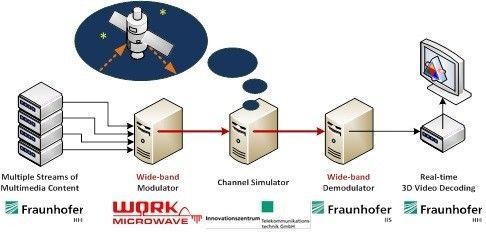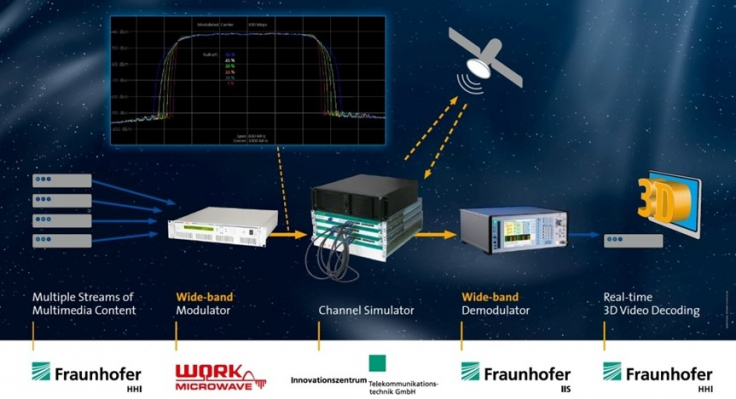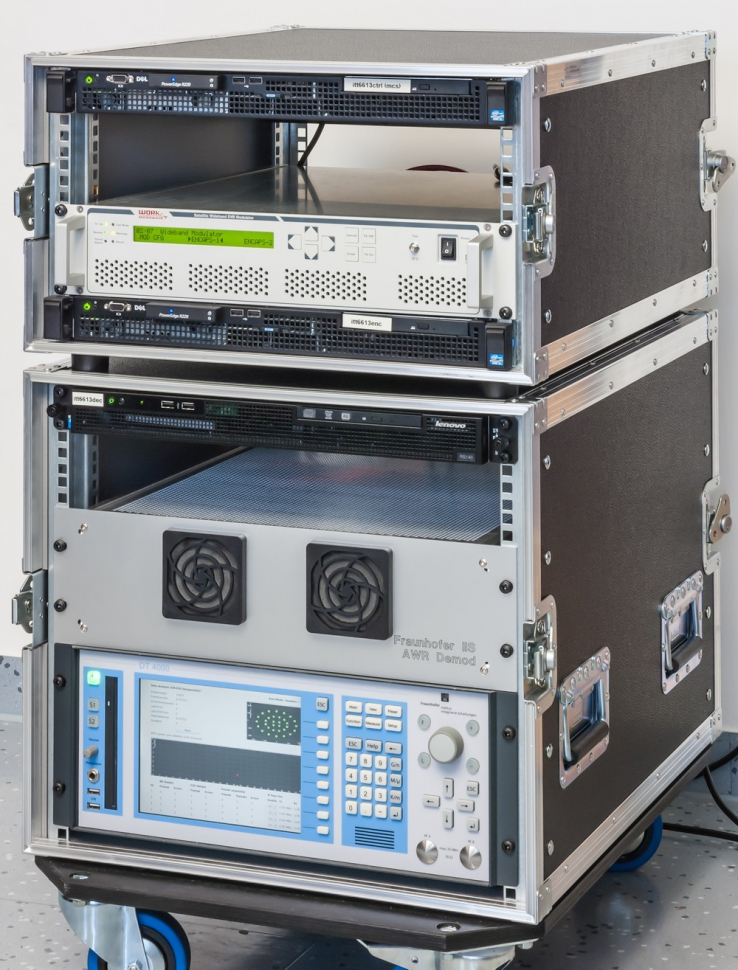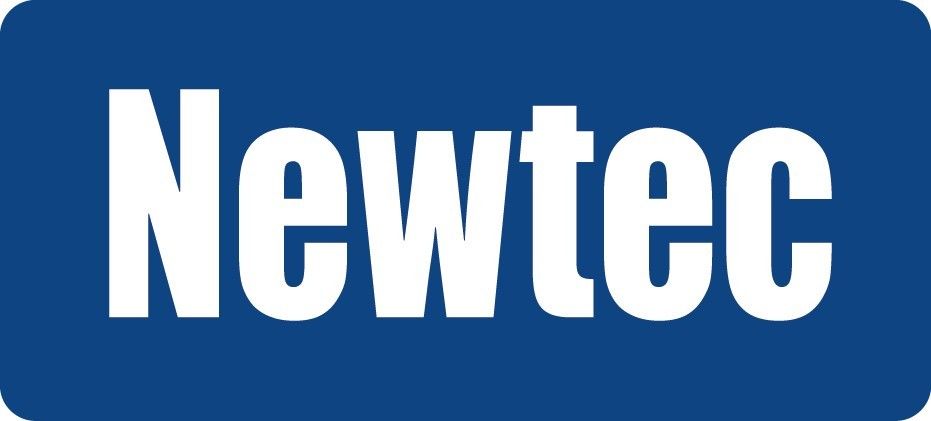
-
StatusCompleted
-
Status date2016-06-02
-
Activity Code7-.020
The central focus of this project is to establish a Direct to Home (DTH) system demonstrator for high throughput multimedia applications. The system and key technologies for the next generation of high speed IP-based broadcasting and broadband access in future Ka band or Q/V bands satellite systems with wideband transponders have been studied, developed and validated. The consortium has built a demonstration testbed, which implements a complete wideband end-to-end system, including a channel emulator, transmitting, and receiving units. Latest techniques for single carrier wideband operation are employed, which are based on the extension to DVB-S2 standard, called DVB-S2X. The consortium contributed to the standardization of DVB-S2X and established Annex E on super-framing, where the waveform developed in this project is termed super-framing format 4 “Flexible Format with VL-SNR PLH tracking”.
In particular, the activity focused on broadcast transmission of advanced multimedia video/IPTV services. Thus, an application layer has been implemented to generate multiple streams of 3D-HD video content for transmission and to decode a specific subset of streams in real-time at the receiver side. In order to enable the transmission of a large number of channels and to support bandwidth hungry applications such as 3DTV or multiple simultaneous HDTV resolutions (such as 1080p) or ultra HDTV, the established testbed supports high channel baud rates up to 400 Mbaud and maximum data rate up to 1.5 Gbps.
Finally, the development clearly reflects and achieves its central objective to demonstrate the practical feasibility of a wideband transmission. Furthermore, the testing capabilities include full-bandwidth emulation of satellite channel effects like linear distortion by IMUX/OMUX filters as well as non-linear distortions from different TWTA-profiles and verification of very low SNR robustness down to -10 dB. This allows for performing a large variety of optimizations like stream-specific QoS adjustment, transponder throughput maximization or IBO/OBO configuration for minimum total degradation. In conclusion, a cutting-edge technology for satellite communications has been established.

- High data rate handling and processing – device internally as well as at interfaces
- Feasibility of wideband processing in hardware and assessment of suitable hardware
- Develop and implement a waveform that satisfies all needs and requirements
- Results of the waveform assessment to be forwarded to standardization
- Demonstration of waveform features
- Future-proof and flexible waveform, which is also suitable for other applications and scenarios
- Demonstration of feasibility of cutting-edge data throughput
- Performance results under realistic channel conditions
- Visualization of gains due to application of enhanced algorithms
- Establishment and qualification of wideband hardware platforms
- Complete end-to-end multimedia transmission system
- Scalable baud rates from 30 up to 400 Mbaud
- Support of a wide SNR range down to -10 dB
- Enhanced bandwidth efficiency by small roll-off factors 5%, 10%, 15% in addition to the also supported common roll-offs 20%, 25%, 35%
- Operation in modes CCM/ACM/VCM
- Equalization techniques at transmitter and receiver side
- Development of high-speed DVB-S2X FEC decoder solution
- Realistic satellite channel models and impairments
- Central monitoring and control station of the testbed for handling of remote access and managing the automated measurement procedures
- Compliant to super-framing format 4 of the DVB-S2X standard, Annex E
- Visualization of received and real-time decoded multimedia content
The system architecture concerning the data path is shown in the schematic. The company logos refer to the corresponding involvement.
On the left hand side of the transmission chain, multiple video streams are cyclically played out to the wideband modulator via Ethernet. These streams are multiplexed into one single-carrier wideband RF signal. The channel simulator manipulates the wideband signal according to the configured satellite impairments and forwards it to the wideband demodulator. Synchronization, demodulation, and decoding are performed. Selected video streams (from the whole multiplex) are provided to the real-time 3D video decoder for rendering by a TV-set.
As a second (not shown) layer, the central monitoring and control computer is connected via Ethernet to all devices for manual configuration access and coordination of automated testing.
The second picture shows the developed testbed devices mounted in a TX-rack-box (top) and a RX-rack-box (bottom).
Project Pictures:
- Schematic of the wideband end-to-end testbed:

- Developed testbed separable in TX-box and RX-box:

Phase 1:
Study Phase with focus on analysis, simulation, and dimensioning:
- 2011 November, Project kick-off
- 2012 April, MS Waveform Acceptance Review
- 2012 August, MS Baseline Design Review
- 2012 November, Start of DVB-S2X Study Mission and Standardization of DVB-S2X
Phase 2:
Implementation, Tests, Performance Validation and Demonstration
- 2012 November, MS Preliminary Design Review
- 2013 June, MS Critical Design Review
- 2015 April, MS Acceptance Review (AR) using old FEC decoder solution
Phase 2E:
Extension w.r.t. development of high-speed FEC decoder and updating Test results due to enhanced performance
- 2015 November, Final Presentation
- 2016 March, MS Final Review (FR) with new FEC decoder solution and testbed delivery to ESA
- 2016 March, Testbed Presentation and Training Sessions
Project completed:
- All implementation and integration completed
- Measurement results deduced, evaluated and validated
- Testbed delivered to ESA and installed
- Final presentation including demonstrations with the testbed






